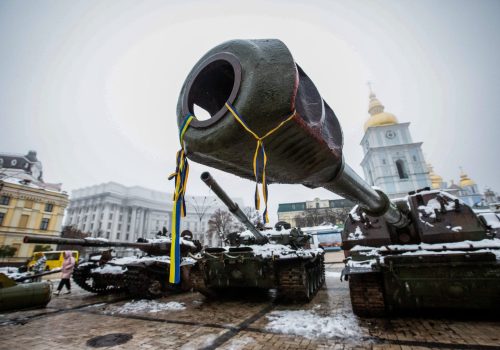The Russian invasion of Ukraine is still far from over, but it is already clear that Ukraine has defended its independence and won the right to become a fully fledged member of the democratic world. This trajectory was further underlined in summer 2022 when Ukraine received official EU candidate nation status.
Ukraine’s future prosperity is not just a matter of ending the war and moving toward membership of the European Union, however. Ahead lies the complex reconstruction of the country’s entire economy and national infrastructure. In order for this to succeed, there can be no return to pre-war conditions. Instead, Ukraine has a once-in-a-lifetime opportunity to reinvent itself as one of the most modern nations on the planet.
Stay updated
As the world watches the Russian invasion of Ukraine unfold, UkraineAlert delivers the best Atlantic Council expert insight and analysis on Ukraine twice a week directly to your inbox.
Thanks to the unprecedented support of Ukraine’s international partners, today’s ambitious visions for a new Ukrainian economy are entirely feasible. This will in all likelihood be a green economy at the cutting edge of the digital revolution.
President Zelenskyy had already set Ukraine on the road to a digital future long before the horrors of Russia’s full-scale invasion. In the early days of his presidency in spring 2019, Zelenskyy identified digitalization as a national priority and vowed to create “a country in a smartphone.”
On the eve of the Russian invasion, Ukraine had already made significant progress in this direction. More than 10 million Ukrainians, or around one-third of the entire adult population, had installed the Diia app, which offered a range of public services and documents in digital format. The impact of this digitalization has been evident during the war, with Ukrainians frequently using virtual documents to identify themselves and pass checkpoints.
The tech sector had also established itself as a key engine of the economy in pre-war Ukraine. By the end of 2021, the IT industry was generating around $6.8 billion in annual export earnings, representing approximately 10% of Ukraine’s overall export revenues.
These developments are encouraging and indicate that Ukraine can seize the unique opportunities that may soon emerge. At the same time, the post-war transformation of the country will force the Ukrainian authorities and the domestic tech industry to think on a far larger scale than ever before. International investments alone will dwarf anything seen in Ukraine since the country regained independence in 1991.
Eurasia Center events

Ukraine’s IT industry certainly has the potential to rise to the coming challenges. On the eve of the invasion, there were more than 250,000 IT engineers in the country working for companies that developed advanced solutions for many of the world’s biggest brands. To harness this potential and position the country for future success, Ukraine’s Ministry of Digital Transformation must engage with the world’s leading experts to develop an effective digital transformation strategy.
This strategy must address a series of core issues such as mastering digital skills, engineering digital infrastructure, the digitalization of public services, and the digital transformation of Ukraine’s business environment. Ukraine must adapt its education system to make sure the emerging generation of young Ukrainians are equipped with the necessary English-language and tech skills to drive the country’s transformation forward. Teachers will need to have expert knowledge, while schools must have sufficient internet access and tech tools.
These innovations need to be applied evenly across the country to make sure progress is consistent and no regions are left behind. This is especially important for regions liberated from Russian occupation. Digitalization must also extend to every branch of public services including healthcare, housing, and municipal services.
Even this very brief overview highlights the vast proportions of the undertaking that lies ahead for Ukraine. The envisaged digital revolution will require the involvement of experts in a wide variety of fields including law, education, energy, medicine, and security as well as IT itself.
The experience of the past ten months leaves little room for doubt that the global community will be ready to support Ukraine’s post-war digital transformation. While the Ukrainian Ministry of Digital Transformation will have the task of coordinating the creation of a digital transformation strategy, the Ministry can call on the support of a range of national governments, international financial institutions such as the World Bank and the EBRD, global development agencies, and many of the world’s largest tech companies.
Today, while Ukraine’s heroic defense against Russian aggression is still underway, it is time to create a broad coalition of allies and establish expert working groups to develop a strategy development fund. The platform for this coalition can be the Digital for Freedom initiative already put forward by the Ministry of Digital Transformation in mid-2022.
Ukraine has already demonstrated that with enough military support, it can win the war. The country’s international partners must also be ready to begin the massive task of reconstruction as soon as circumstances allow. A comprehensive and ambitious digital transformation strategy can serve as one of the foundational documents for the coordination of efforts to make the new Ukraine an example of progress for the entire world.
Anatoly Motkin is president of the StrategEast Center, an independent institution working to develop Eurasia’s digital economy in collaboration with international financial institutions, development agencies, global tech companies, and Eurasian governments.
Further reading
The views expressed in UkraineAlert are solely those of the authors and do not necessarily reflect the views of the Atlantic Council, its staff, or its supporters.

The Eurasia Center’s mission is to enhance transatlantic cooperation in promoting stability, democratic values and prosperity in Eurasia, from Eastern Europe and Turkey in the West to the Caucasus, Russia and Central Asia in the East.
Follow us on social media
and support our work
Image: (Photo by Pavlo Gonchar / SOPA Images/Sipa USA)




